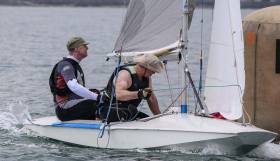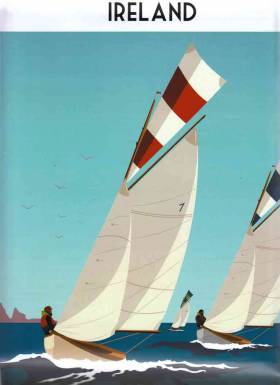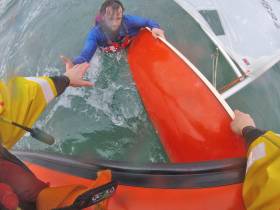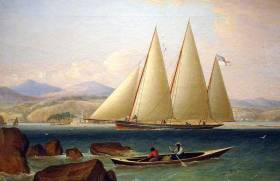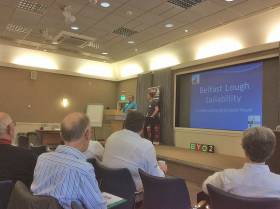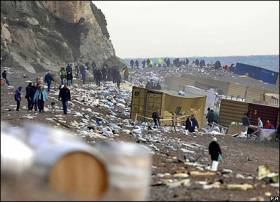Displaying items by tag: Belfast Lough
A small group of Fireballs, combined with a slightly larger group of 420s enjoyed a light weather start to the regatta season under the burgee of Ballyholme Yacht Club, on Belfast Lough’s southern shore for the Ulster Championships this past weekend. Ballyholme has always been a popular destination for the Fireballs with a combination of an excellent Race Officer in Robin Gray and traditional northern hospitality the mainstays of that attraction. While our smaller numbers changed the requirement for on-site hospitality, Robin Gray was as excellent as ever, getting six races in in challenging circumstances, particularly on the Saturday. Sunday was easier in terms of the wind direction but for the competitors, the challenge of going the right way and avoiding the wind lulls on the course was just as demanding.
Noel Butler and Stephen Oram (National Yacht Club, 15061) dominated the winners’ enclosure by taking five race wins. In the sixth race they swapped roles on the boat, with Stephen taking over as helm. That led to an opening of the door to another winner, Niall McGrotty and Neil Cramer (Skerries Sailing Club, 14938) which was enough to secure second overall ahead of Michael Ennis & Marie Barry (National Yacht Club, 14854). However, while Butler & Oram won all the races, they didn’t have things completely their own way even in those races. In the first race of the Saturday, Frank Miller & Cormac Bradley (Dun Laoghaire Motor Yacht Club, 14713) led around the first weather mark and Michael & Marie pushed them all the way in the fifth race before a tight cover had to be applied on the last leg of the course from Mark 4 of the trapezoid to the finish to make sure Michael & Marie didn’t sneak out from underneath them. Niall & Neil also pushed the eventual winners and the “pink ladies”, Louise McKenna and Hermine O’Keeffe (Royal St George Yacht Club, 14691) while not quite pushing the overall winners were also close enough to benefit from any mistakes the leaders made. Saturday started overcast and cool but cleared and warmed as the day progressed, to the extent that we came ashore after three races to blue skies and glorious sunshine. Saturday’s wind was better than Sunday with some trapezing being possible. The consequence was that the racing was reasonably tightly bunched. Dinner was eaten al fresco at a nearby by pub/restaurant. Our weather was made all the more intriguing by hearing that DBSC’s racing in Dun Laoghaire had been cancelled due to strong wind.
On Sunday we woke to clear blue skies and a much more fickle breeze but Race Officer Robin Gray made an early declaration of his intent by not appearing at the club but rather, going afloat on the committee boat directly from Bangor marina. While some of the other light crews may have had some trapezing on Sunday, this correspondent only hooked up very rarely during the day’s proceedings. As the biggest combination on the water, Miller & Bradley were off the pace in the lighter first two races and it was only in the last race when there was a bit more wind that they were able to stay with their opposition. Trapezoid courses were the order of the weekend in order to accommodate the two fleets and the preference of the 420s for this course configuration.
|
Fireball Ulsters – Ballyholme Yacht Club (with 420s) |
R1 |
R2 |
R3 |
R4 |
R5 |
R6 |
Nett |
|||
|
1 |
Noel Butler & Stephen Oram |
NYC |
15061 |
1 |
1 |
1 |
1 |
1 |
5 |
5 |
|
2 |
Niall McGrotty & Neil Cramer |
SSC |
14938 |
2 |
5 |
2 |
3 |
3 |
1 |
11 |
|
3 |
Michael Ennis & Marie Barry |
NYC |
14854 |
4 |
3 |
4 |
2 |
2 |
3 |
14 |
Irish Sailing's Classic Boats Get The French Morbihan Mystique
Three weeks hence from this morning, on Saturday May 19th, an unlikely convoy of vehicles with a very special collection of unique vintage boats and people will emerge in Cherbourg from Irish Ferries’ ship just in from Rosslare writes W M Nixon. Meanwhile, well to the west in northern Brittany, a similarly rare group with antique boats of a different type will have disembarked in Roscoff from the Brittany Ferries vessel from Cork. By that night, if all goes according to plan, both groups – people and boats alike - will be united a long way away, in the little port of Arradon on the shores of the Morbihan, the island-studded inland sea at the heart of its own Department, the most southerly part of Brittany.
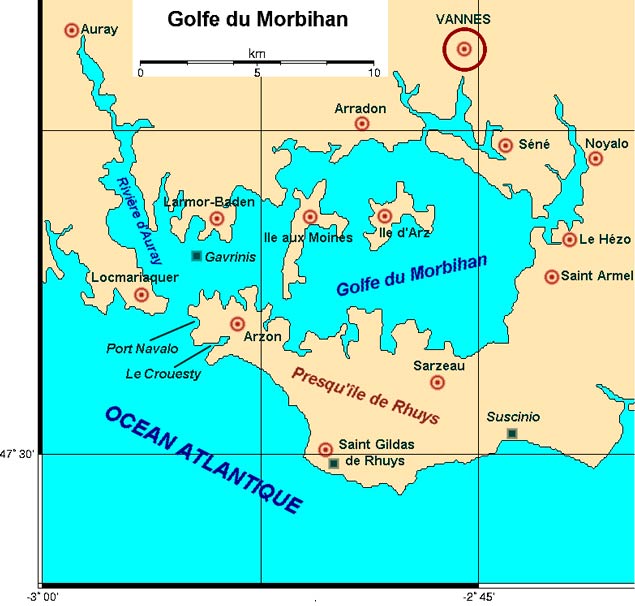 A sailing paradise. In detail, there are sixty islands in the Morbihan. The Irish crews in the Water Wags and Howth 17s will be based at Arradon on the north shore.
A sailing paradise. In detail, there are sixty islands in the Morbihan. The Irish crews in the Water Wags and Howth 17s will be based at Arradon on the north shore.
The Irish classic boats and those who sail them will have arrived to immerse themselves in the fleet of more than 1,300 other unusual craft in a very French celebration of sailing and pride in individualistic boat ownership. It’s a wonderfully complex biennial celebration which uses the magic waters of the Morbihan, where sea and land completely intertwine in the midst of the sweetest countryside with enchanting village ports, to provide a unique playground for boats of all types and sizes.
 The replica of Peter the Great’s 1703-built Shtandard will be one of the largest vessels at the Morbihan.
The replica of Peter the Great’s 1703-built Shtandard will be one of the largest vessels at the Morbihan.
At the time of writing, they’re expected to range in size from the extraordinary Russian re-creation of Peter the Great’s huge warship of 1703, the Shtandart, right down to a selection of the sometimes decidedly unusual yet effective little craft which emanate from the creative minds to be found in Francois Vivier’s design office. In between, we’ve everything from the America’s Cup 12 Metre France through a comprehensive selection of traditional sailing fishing boats and classic yacht from several maritime nations, and on through a goodly fleet of other traditional craft with a strong representation of the Bantry Boats, until at the lower end of the size scale, we find some little boats which are very odd indeed, owner-designed craft which can best be categorized somewhere on the scale which ranges from Rather Quirky to Utterly Bonkers.
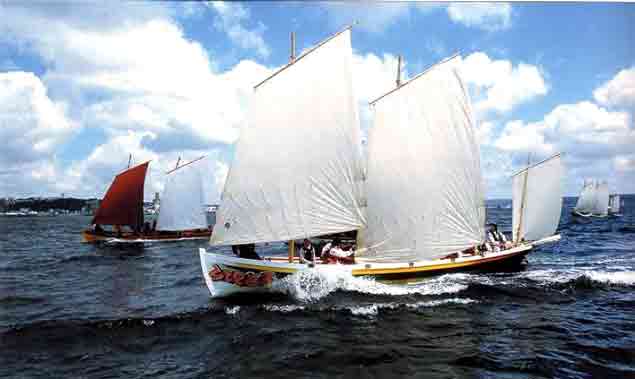 Bantry Boats racing in France. Based on the ship’s boat left behind in Bantry Bay after the failed invasion of 1796, the Bantry boat was stored for more than a hundred years at Bantry House before being moved to the National Museum. Under an iniative inspired by Hal Sisk, they are now the basis of a lively fleet on both sides of the Atlantic, and will be a feature of the Morbihan Week.
Bantry Boats racing in France. Based on the ship’s boat left behind in Bantry Bay after the failed invasion of 1796, the Bantry boat was stored for more than a hundred years at Bantry House before being moved to the National Museum. Under an iniative inspired by Hal Sisk, they are now the basis of a lively fleet on both sides of the Atlantic, and will be a feature of the Morbihan Week.
 They’re in better heart than ever. The Water Wags at a recent “training weekend” at Killenure on Lough Ree. Next month they will be making their second visit to the biennial Morbihan Week in southern Brittany.
They’re in better heart than ever. The Water Wags at a recent “training weekend” at Killenure on Lough Ree. Next month they will be making their second visit to the biennial Morbihan Week in southern Brittany.
In the midst of the huge fleet, there’ll be twelve Water Wags and six Howth 17s from Ireland. Small and all as they are by comparison with some of the enormous traditional fishing craft and Tall Ships taking part, they will be accorded honoured status partly on account of age. The Water Wags of 1887 origin, with the present class a re-worked larger design from 1900, introduced the One-Design concept. And as the Howth 17s are of 1898 origin, they are accorded the special honour of being the world’s oldest one design keelboat class still sailing as originally designed.
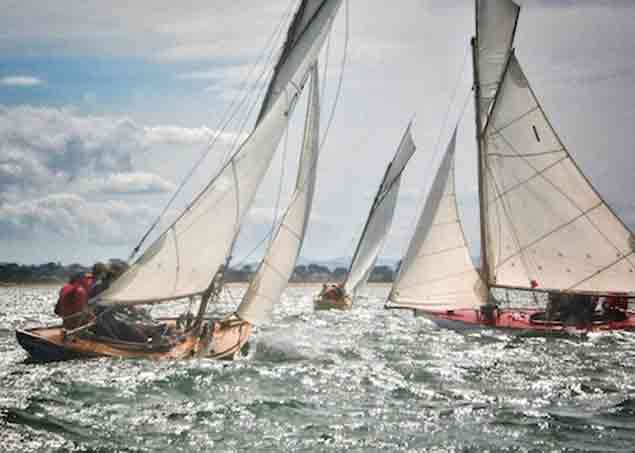 Howth 17s in full cry. They will be making their first visit to the Morbihan festival, but their newest sister-ship is being built nearby at Skol ar Mor.
Howth 17s in full cry. They will be making their first visit to the Morbihan festival, but their newest sister-ship is being built nearby at Skol ar Mor.
Further to all that, both classes bring international status through coming from Ireland, and few have come further, even if the little Irish boats are sensibly using the ferries. But we will also see Irish Sea representation with boats which have sailed there, with the beautifully restored classic Laurent Giles-designed Carbineer 46 Sylvana voyaging from Northern Ireland, while the irrepressible Joe Pennington from the Isle of Man is entered with his restored 1895-built 36ft Manx longliner Master Frank, which might find it interesting to have a spot of competition with the comparable French-based Essex smack Unity of Lynn.
However, for the little Irish boats, it’s a formidable logistical challenge. The Water Wags - in which the Olympic Mother Cathy MacAleavey has been setting the racing pace of late, though David MacFarlane won on Wednesday – are in good hands as Carol O’Rourke is coordinating their arrangements. But anyway they’ve useful experience here, as seven of them travelled to the 2015 Semaine du Golfe du Morbihan, and eight came back. They returned with a new boat for Adam Winkelmann which had been built to the class’s ancient designs by Mike Newmeyer and his team at the inspirational boat-building school Skol ar Mor.
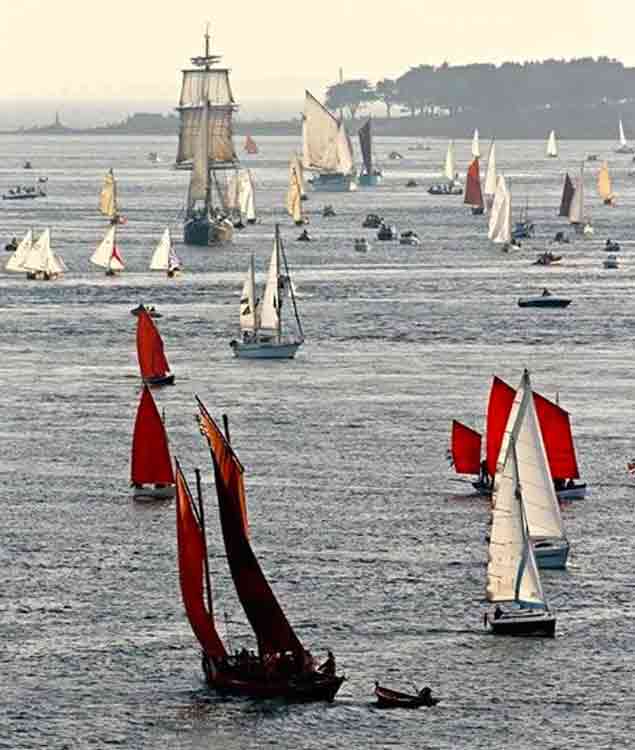 Eclectic fleet......the Morbihan Fesitval in 2015. Four of the Water Wags are just about visible left centre
Eclectic fleet......the Morbihan Fesitval in 2015. Four of the Water Wags are just about visible left centre
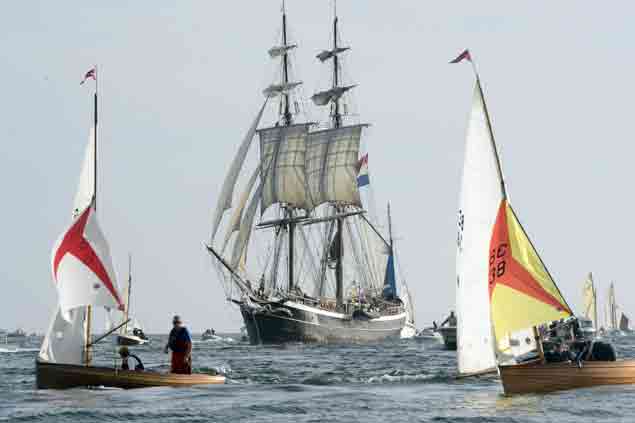 The popular Dutch sail training ship Morgenster was a welcome visitor to the festival in 2015, and is seen here approaching the entrance to the Morbihan in company with a couple of Water Wags
The popular Dutch sail training ship Morgenster was a welcome visitor to the festival in 2015, and is seen here approaching the entrance to the Morbihan in company with a couple of Water Wags
Skol ar Mor – which is located near the entrance to the Morbihan – is currently building a new Howth 17 for Ian and Judith Malcolm, but she won’t be finished until July as her construction is timed to phase in with the school’s term periods. But in any case, the Malcolms are keen to make their debut for the Howth 17s at Morbihan with their 1898-vintage boat Aura, which they’ve owned, lovingly cared for and raced very regularly since 1980.
It’s not the first time the Howth 17s have travelled far from their ancestral home, in fact it’s not the first time they’ve been to France, as a trio went to the Brest Festival in 1972. But road travel technology for little old boats wasn’t so advanced 45 years ago, so it wasn’t until 1998 that another road migration was taken on, with seven of them going to Belfast Lough to celebrate their centenary at their birthplace at Carrickfergus. They sailed the 90 miles home.
Then in 2005 they’d a seriously major movement, when an incredible 15 managed to get to the Glandore Classics involving an efficiently-organised set of low loaders which could take the boats down to West Cork three or even four at a time.
The Howth 17s are nothing if not individualistic, so the regimentation essential to the success of this expedition was exhausting for them. It took a while for the normal busy season of racing (usually they’ve sixty races a year) to resume once they’d got home. So since then, they’ve been building up a group of owners within the class who have proper road trailers, and that was the means used to get seven boats to Belfast Lough for last year’s 150th Anniversaries of Carrickfergus Sailing Club and Royal Ulster Yacht Club, together with the celebration of the yacht and boat-building achievement of the John Hilditch yard at Carrickfergus.
 The opportunity to compare different rigs and boat types at the Morbihan is unrivalled. This is the Looe Lugger Our Boys of Plymouth..........
The opportunity to compare different rigs and boat types at the Morbihan is unrivalled. This is the Looe Lugger Our Boys of Plymouth..........
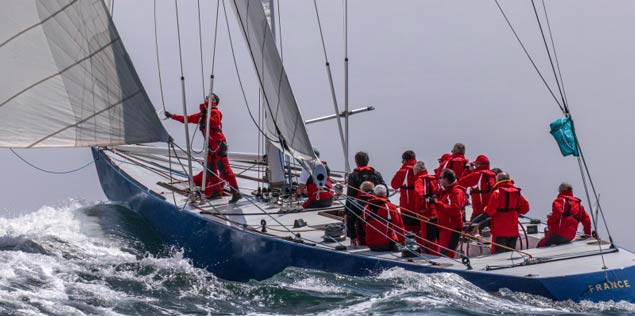 ......and this is the former America’s Cup 12 Metre France
......and this is the former America’s Cup 12 Metre France
But there’s a heck of a difference between taking just part of a morning to road-trail mostly on motorways from Howth to Bangor, and trailing your boat from Dublin to the Morbihan via the Rosslare-Cherbourg ferry. The Water Wags know they can do it, but for the much heavier Howth 17s and their interesting selection of four-wheel-drive towing vehicles, they’re facing a total haul of 540 kilometres, 348 of them in France.
Naturally, there are those who’ll say that boats of this vintage should live pampered lives. But the Howth 17s are nothing if not adventurous, and Irish Ferries have been so much taken with all this that four of the boats and their towing vehicles are travelling the ferries there and back for free, so between them the six travelling equipes have only had to divvy up for two boats’ cost.
Nevertheless as two of the boats – Aura and Roddy Cooper’s Leila - are from the original 1898 Hilditch-built five, they’re moving a uniquely precious cargo on a project very far removed from their origins. So far removed, in fact, that I can’t help but imagine John Hilditch urging on his men on a Monday morning early in the Spring of 1898 with the inspiring words: “C’mon, lads, we have to build these new Howth boats strong and true, for in 119 years time their owners will want to trail them the 217 miles from Cherbourg to Vannes on some sort of road cart.”
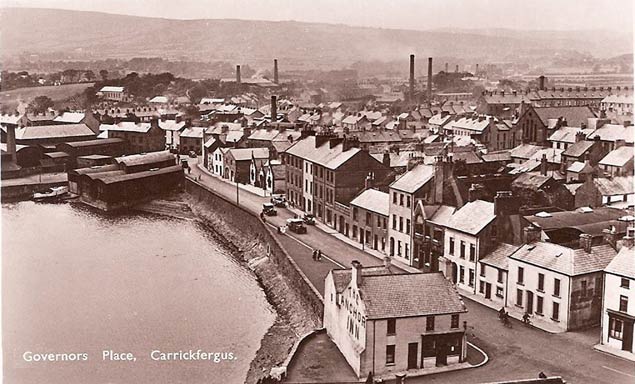 Change of scene. The Howth 17s were built in Carrickfergus in 1898 in Hilditch’s Boatyard in those black sheds on the waterfront at the head of the harbour in an industrial town.......
Change of scene. The Howth 17s were built in Carrickfergus in 1898 in Hilditch’s Boatyard in those black sheds on the waterfront at the head of the harbour in an industrial town....... ....but next month they’ll be sailing in these agreeable surroundings in the heart of the Morbihan
....but next month they’ll be sailing in these agreeable surroundings in the heart of the Morbihan
Quite. Either way, it will be an exhausting journey, but it’s the sort of project which re-energises those involved as it moves along, and once they’ve got to the Morbihan, the Water Wag and Howth 17s sailors will find themelves among kindred spirits. It’s something they need from time to time. Only the other day I was asked to reveal to a non-sailor what the Water Wags are all about in 2017, and found it very challenging. For how can you explain the inexplicable?
Around the Morbihan, there’ll be no need to explain. Yet even in France supposedly among members of the same nautical religion, the Howth 17s and the Water Wags will find themselves slightly at odds with the crew of some other boat types, as the essence of both the Irish classes is that they race a lot, so much so that both classes are healthier than ever. But that is not always to the taste of all those who simply love old boats for themselves, and find that keeping them in good order and sailing them in non-competitive style on various expeditions within the ambit of the Semaine du Golfe du Morbihan is all that is required.
But the Morbihan has so much to offer that there’s something for everyone, and for smaller racing boats that want racing, there’ll be racing available. As for others who simply like sport in sailing challenging bits of sea, the tides in the Morbihan whoosh in and out through the narrow entrance with such vigour that many treat it like a nautical ski slope.
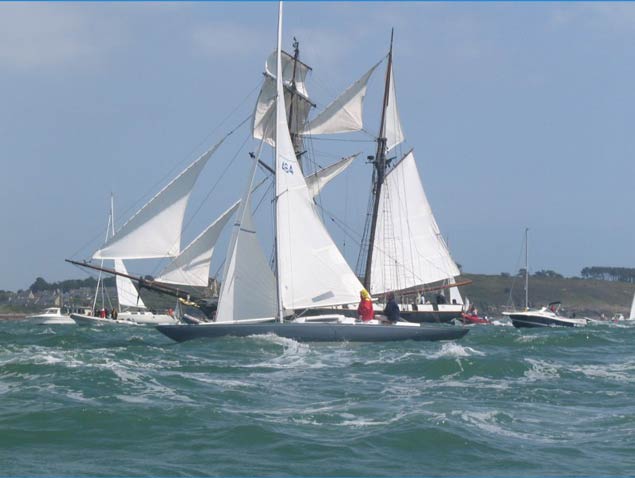 The manageable liveliness of the tide-riven waters in the Morbihan entrance is integral to the way the event is staged.......
The manageable liveliness of the tide-riven waters in the Morbihan entrance is integral to the way the event is staged.......
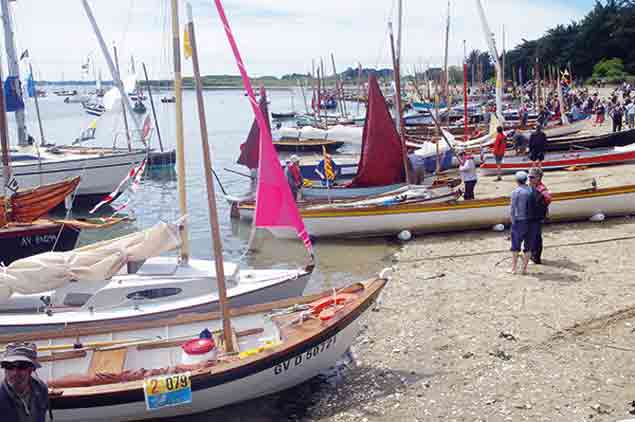 ......but for balance, sheltered beach time is expected
......but for balance, sheltered beach time is expected
This is markedly unlike the attitude at the entrance to Strangford Lough. There, the tide-race on the bar is admittedly on a bigger scale, but it’s regarded as something to be avoided. At the Morbihan by contrast, there are small boat sailors who’ll spend their whole day crawling in the eddies against the tide, and then returning with it in the middle of the full exuberant burst of the rip.
For those with more leisurely tastes, there are all sorts of waterside establishments where lunch can go on for ever, but be very sure to have secured your table by 12:30pm. And as for visiting other boats, that too can go on for ever.
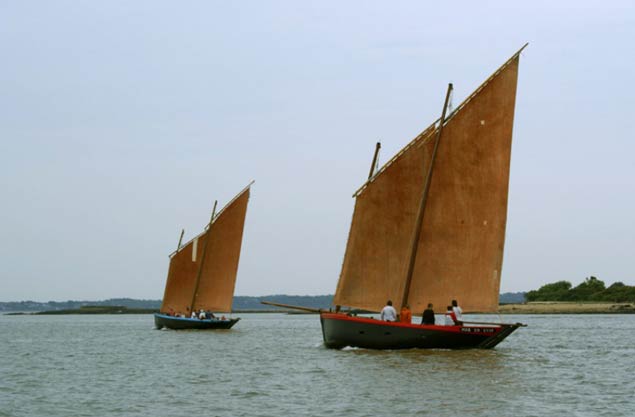 The sinagot is the indigenous traditional fishing boat of the Morbihan
The sinagot is the indigenous traditional fishing boat of the Morbihan
Certainly there are some with which the Howth folk should link up. A noted presence will be the McGruer 8 Metre Cruiser/Racer Orana of 1959 vintage. For many years she was based in Howth under Johnny Pearson’s ownership, and she had her moments, including winning the 1966 RORC Beaumaris-Cork Race overall. She was the first yacht I ever did the Lambay Race aboard, and when you do your first Lambay Race with the likes of Johnny Pearson, Bob Fannin and Brendan Murray, you learn an awful lot about what living in Howth is going to involve, and you even learn a little about racing round Lambay.
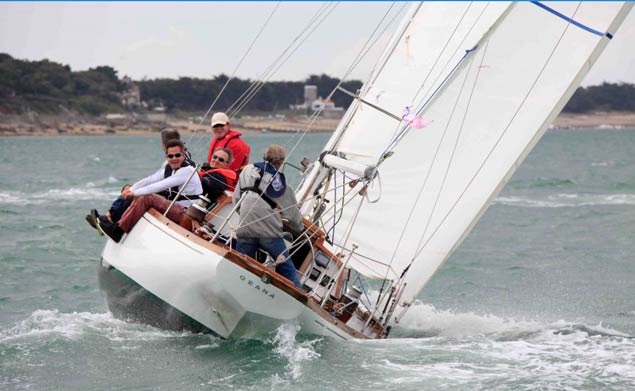 The 1959 McGruer-designed 8 Metre Cruiser-Racer Orana was Howth-based for many years, and was overall winner of the 1966 RORC Beaumaris-Cork Race. After being under the radar for decades, she has re-emerged in French ownership as a participant at Morbihan Week 2017
The 1959 McGruer-designed 8 Metre Cruiser-Racer Orana was Howth-based for many years, and was overall winner of the 1966 RORC Beaumaris-Cork Race. After being under the radar for decades, she has re-emerged in French ownership as a participant at Morbihan Week 2017
Orana had been off the radar for decades, but now she has re-emerged, spic and span in French ownership and ready to strut her stuff in the Morbihan in three weeks time when she’ll be part of a mind-blowing feet. In fact, so diverse is the fleet, that while most of it will be the challenge of recognising what’s going past, some are worth seeking out directly, and one such is surely the famous Pen Duick, Eric Tabarly’s original boat, a Fife-designed 15-tonner which started life in 1898 at Carrigaloe on Cork Harbour.
Originally, she was given the unlovely name of Yum, and her owner, one Adolphus Fowler of the Royal Munster YC, was evidently feeling prosperous, for at the same time he had the Carrigaloe yard built him the Cork Harbour One Design Jap.
Both boats still sail the sea, but mercifully Yum soon received a pleasanter name as she was quickly sold, and she is now immortalised as Pen Duick, the eternal beauty brought back to life by Eric Tabarly to be an extraordinary link between William Fife of Scotland, Cork Harbour in Ireland, and all that is best in French sailing in Brittany.
In a league like this, the little boats from Ireland will need to do something special to fulfill their role. But I think that the poster that the Howth 17s commissioned from local artist Carol O’Mara for display on the various sites around the Morbihan is definitely a step in the right direction. There’ll be so many messages flying around from all sources that something which says what it wants to say so well, so simply, and so directly will make the most impact.
In all last year’s celebrations of the 150th Anniversaries of Royal Ulster Yacht Club and Carrickfergus Sailing Club on Belfast Lough, it was generally overlooked that neither is the senior club on the lough, even though both were founded way back in 1866 writes W M Nixon.
But now friendly little old Holywood Yacht Club, with its hospitable clubhouse and drying anchorage close east of Belfast itself, no longer needs to draw attention to the fact that it was founded in 1862, even if that clearly makes it the daddy of them all. For on the last Saturday night of March 2017, Holywood Yacht Club put itself in a league of its own as it was graced with the presence of 71-year-old singer-songwriter Sir George Ivan Morrison OBE. And he was so keen to do what he does best, which is to sing his heart out with his own unique version of soul music and rhythm and blues, that it made for an incredible night.
The occasion was a semi-surprise charity gig which has already become – after just ten days - a piece of rock and roll legend. It was a fund-raiser for the Marie Curie hospice in East Belfast in memory of the late Billy Deane. His old mates laid it on in style, and the bands from times past (in some instances, times very long past) who joined the show included Inis Mor, the Alan McKelvey Blues Band, the Leah McConnell Band, Lee Hedley’s Ram Jam, George Jones and Friends, and the Pikestone Preachers.
With a line–up like that, the audience felt they were more than getting their money’s worth for tickets which had cost just £10. It has to have been the best tenner they’ve ever spent, for next on stage was the Monarchs, who had been at the top of their popularity in the early 1960s.
 The tide’s in, so the sailors are out and about. Toppers and Lasers in strength on Holywood YC’s launching ramp at high water. Photo courtesy HYC
The tide’s in, so the sailors are out and about. Toppers and Lasers in strength on Holywood YC’s launching ramp at high water. Photo courtesy HYC
 Van Morrison in full kit at the Theatre Ace Hotel near the other Hollywood in Los Angeles on St Patrick’s Day, just eight days before he made his unexpected appearance at Holywood in County Down
Van Morrison in full kit at the Theatre Ace Hotel near the other Hollywood in Los Angeles on St Patrick’s Day, just eight days before he made his unexpected appearance at Holywood in County Down
At that time their lead singer was a very young Van Morrison. But he left soon after an early 1960s tour of Germany to go solo or have his own band. We can remember him building his career with anything that was on offer, including performing for friends at parties in little houses hidden among the rolling hills along the west shore of Strangford Lough, around 1966 and ’67.
An unreal feeling of those days of fifty and more years ago will have permeated Holywood Yacht Club when the legend stepped up on stage to be re-united with the Monarchs for the first time in 54 years. He gave it his best with his first number being his own version of Sweet Little Sixteen as a tribute to the recently departed Chuck Berry. Along with Van Morrison, the original Monarch survivors Billy McAllen, Roy Kane and George Jones were getting the support of Mervyn Crawford on saxophone and Kevin Brennan on keyboards.
A new standard has been set in sailing club entertainment – has any other club ever had Van Morrison on stage?
To talk numbers, Roy Kane quipped that the originals between them provided 355 years of rock and roll stage experience. The money raised had been just £1,600, but that was before anyone knew Van the Man was on his way. Modest funds perhaps, but the great memories are now purest priceless gold. And in a year’s time, just about everyone for miles around will somehow find they well remember being there…
Bangor Lifeboat Rescues Man From Capsized Dinghy
#RNLI - Following yesterday’s hoax calls, Bangor RNLI’s lifeboat volunteers rescued a man clinging to a capsized dinghy in Ballyholme Bay this afternoon (Monday 3 April).
The casualty, a 26-year old man, had quickly got into difficulty and capsized after launching from the Belfast Lough beach in a strong offshore wind gusting up to 30 knots.
This was seen by a member of the public who called 999, and CGOC Belfast Coastguard requested Bangor RNLI to respond.
Arriving on scene within minutes, the crew were delighted to see that the man had stayed with his boat and not tried to make it to shore. They were also happy to report that he was wearing appropriate safety gear: a wetsuit with a buoyancy aid.
After taking the casualty on board and assessing that he was uninjured, they returned him and his boat to the beach where the coastguard were waiting to assist.
Bangor lifeboat helm James Gillespie said: “This man clearly made the wrong decision to attempt to sail in a new boat in such conditions, but by wearing appropriate wet weather gear and staying with his boat he made our rescue much easier.
“The body tires quickly is cold water and he made the right decision to stay with his boat, knowing that his plight had been seen from the shore.”
Bangor RNLI’s deputy launching authority, Bryan Lawther added: “We are delighted to have been to help this man and bring him to safety. He has been advised to further his sailing knowledge with the assistance of a yacht club where rescue services are always on hand for learners.
“After yesterday’s hoax calls, this rescue highlights the importance of our service and our willingness to attend any genuine call.”
#BelfastLough - A sea captain has been convicted of being drunk on duty while piloting a merchant vessel in Belfast Lough last year.
As the Belfast Telegraph reports, Eugenijus Tulauskas was found to be nearly four times over the legal limit when he was arrested in September 2016 after a harbour pilot was forced to assist in control of the cargo ship.
Tulauskas, who has since lost his job, was fined £1,500 by a judge at Belfast Magistrates’ Court this week after initially contesting the charge, claiming he was not on duty at the time.
The Belfast Telegraph has more on the story HERE.
Sailing's Gaff Rig: Ireland's Part in its Downfall
The 35th staging of international races for the 176-year-old America’s Cup is rising rapidly up the agenda. The opening jousts for challengers begin on 26th May 2017 at the first-time-selected venue of Bermuda, and the cup series itself starts there on 17th June. It’s time to focus on the sailing paradise of Bermuda, and particularly its role in changing the shape of sails in mainstream sailing. W M Nixon takes a typically skewed look at what it all might mean.
The irony of it is that, long before the rig was popularly accepted, it was the sailors of Bermuda who were credited with the invention of the jib-headed triangular shape for mainsails. This dominated yacht design for nearly a century. Yet in 2017, as the inevitably trend-setting America’s Cup finally comes to Bermuda for the first time, it will be raced by sailing machines – the word “boats” seems inadequate – which are setting what looks very like an extremely modern variation of the classic gaff rig.
For what are today’s state-of-the-art square-headed mainsails other than an attempt to get as much sail area as possible within the limits set by the height of the mast and the length of the boom? And what rig was based on the same premise? Exactly. The gaff rig, and its very useful cousin, the sprit rig.
 Is this or is this not gaff rig? America’s Cup defenders Oracle in action off San Francisco
Is this or is this not gaff rig? America’s Cup defenders Oracle in action off San Francisco
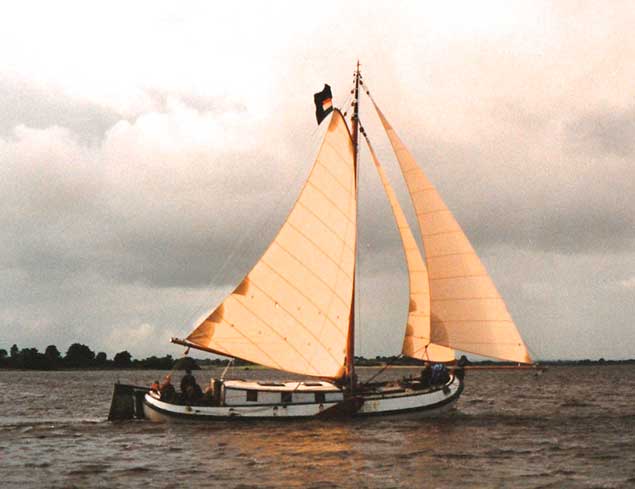 David Beattie’s Dutch Lemsteraak Schollevaer, sailing here on Lough Ree, indicates that classic Dutch yachts tended towards shortening their gaff booms to such an extent that for a period they were almost Bermudan rigged. Photo: W M Nixon
David Beattie’s Dutch Lemsteraak Schollevaer, sailing here on Lough Ree, indicates that classic Dutch yachts tended towards shortening their gaff booms to such an extent that for a period they were almost Bermudan rigged. Photo: W M Nixon
Yet at a certain stage, as the pioneering Dutch yachtsmen moved from the sprit rig to the gaff rig, the gaff booms became so short that the sailing world was very close to having jib-headed mainsails. But boats setting bisquine rig or something very similar showed what could be done with topsails, and longer gaff booms with topsails above them became the norm.
In due course, the logic of having lighter masts, and mainsail and topsail one and the same with no booms between them, became inescapable. Yet because so many people, relatively speaking, had by this time taken up sailing, the arguments about which rig, gaff or Bermudan, was superior soon became ludicrously heated.
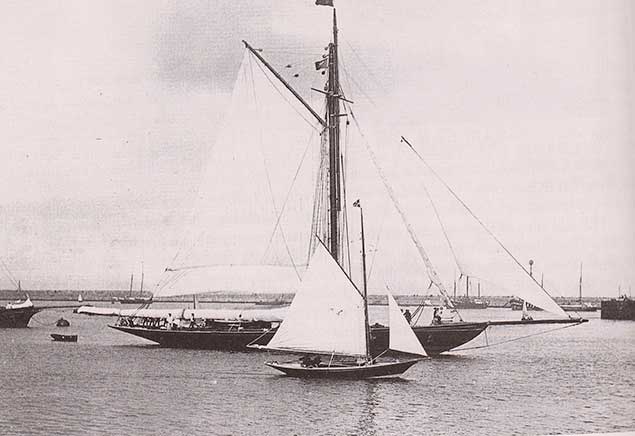 The Prince of Wales cutter Britannia in Dun Laoghaire in 1893, newly-built and on passage from the Clyde to the Solent, showing how a racing gaff rig could be shortened down for sea-going passages in heavy weather, with the topmast safely housed and a loose-footed gaff-headed trisail set instead of the full mainsail.
The Prince of Wales cutter Britannia in Dun Laoghaire in 1893, newly-built and on passage from the Clyde to the Solent, showing how a racing gaff rig could be shortened down for sea-going passages in heavy weather, with the topmast safely housed and a loose-footed gaff-headed trisail set instead of the full mainsail.
Traditionalists argued that while Bermudan rig might be just about acceptable for inshore racing in sheltered water, anyone going cruising or racing offshore needed the rugged gaff rig with its compact mast, possibly heightened by a topmast which could he lowered and housed against the forward side of the mainmast when at sea and conditions deteriorated.
And then there were and still are the uber-traditionalists who argue that if gaff rig had been good enough for their fathers and forefathers before them, then it was good enough for them, and you don’t have to go any further than Howth, Connemara or Falmouth to find them in their droves.
A new factor entered the equation with the development of the heritage industry, which concluded that that the loss of familiarity with handling the formerly-universal gaff rig was a real cultural threat. So in 1963 the Old Gaffers Association came into being at much the same time as the Classic Yacht Movement was starting to gain traction, and thus the preservation of gaff rig was being upheld from both ends of the wealthy to barely-getting-by spectrum.
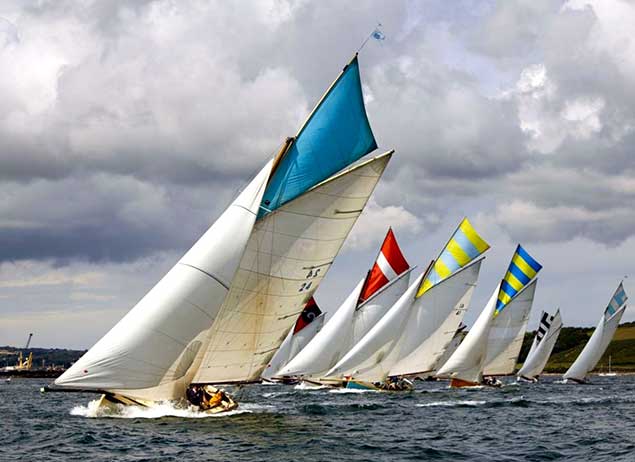 Where gaff rig is the norm – Falmouth Working Boats racing. Under ancient legislation, it is only permissible to dredge for oysters in Falmouth Harbour under sail, and the working boat with adjustable performance has developed as a result.
Where gaff rig is the norm – Falmouth Working Boats racing. Under ancient legislation, it is only permissible to dredge for oysters in Falmouth Harbour under sail, and the working boat with adjustable performance has developed as a result.
It was all great fun if you didn’t take it took seriously, but in its day, some people took it very seriously indeed and a few still do, so we’ll give the pot a very good stir by revealing that it was Irish sailors who played a key role in making Bermudan rig mainstream.
Our header image reveals that Bermudan rig in a quite sophistcated form was not unknown from 1834 onwards. But nevertheless even in crack yachts like Belfast linen magnate John Mulholland’s schooner Egeria of 1865 vintage, and John Jameson of Dublin’s cutter Irex designed by Alexander Richardson in 1884, the relatively crude gaff topsails being set still showed how closely they were descended from lug rigs which in turn had evolved from trying to get simple squaresails to set closer to the wind.
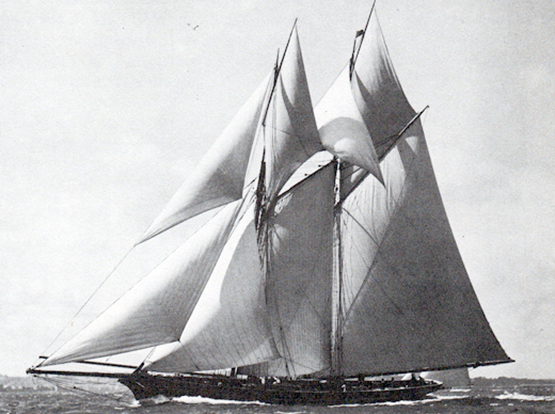 John Mulholland’s 99ft schooner Egeria of 1865 vintage set topsails which were developments of lug sails
John Mulholland’s 99ft schooner Egeria of 1865 vintage set topsails which were developments of lug sails
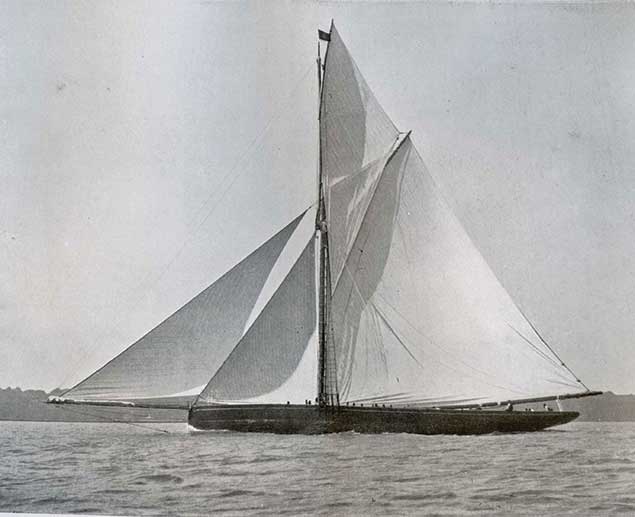 John Jameson’s Irex of 1884 originally set a topsail which looked very out-of-date just ten years later
John Jameson’s Irex of 1884 originally set a topsail which looked very out-of-date just ten years later
But by the late 1880s, topsails were becoming more clearly jib headed, and for a while they used a combination of short mainmast, a short topmast, and a topsail yard to provide their height, which could resulted in a distinctly stunted look when on a dead run, as is seen in the Scottish ironmaster Peter Donaldson’s all-conquering 70ft 40-rater Isolde, designed and built by Fife in 1895.
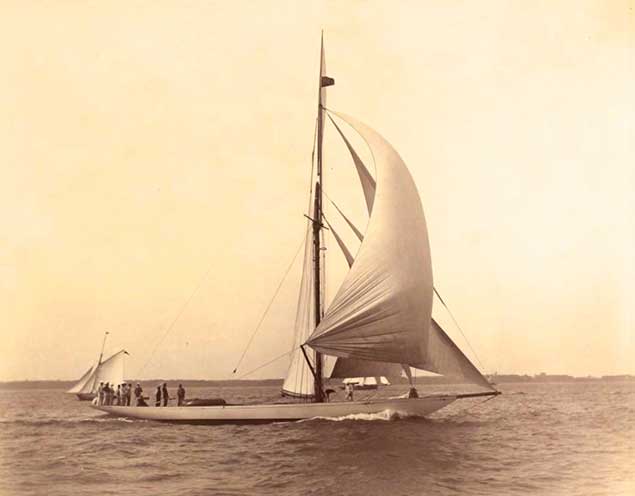 Fast boat, dumpy rig? Peter Donaldson’s successful Isolde of 1895 looked to have a very low-slung rig when she squared off on the run
Fast boat, dumpy rig? Peter Donaldson’s successful Isolde of 1895 looked to have a very low-slung rig when she squared off on the run
It is the famous photo of the new Belfast Lough 25ft One Designs at their start in the RUYC Regatta in July 1898 - their second season – which best shows how gaff rig had developed in the decade since Irex was the boat to beat. The BLOD 25’s have topsails which use long yard to sit as flush as possible with the mast. As the luff length of the topsail was actually longer than the luff length of the mainsail, and as it is luff length which does most of the work in making to windward, getting the topsail and mainsail to set as one was vital in achieving best performance.
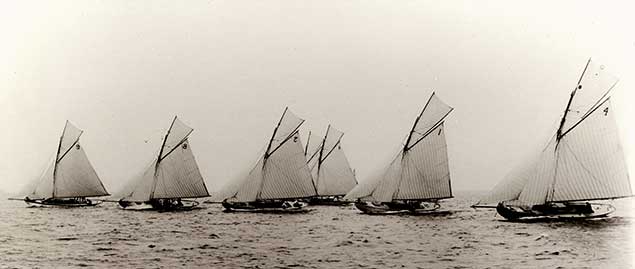 Serious topsails. With a luff length longer than the luff length of the mainsail, the Belfast Lough 25ft ODs had to get the set of their topsails just right.
Serious topsails. With a luff length longer than the luff length of the mainsail, the Belfast Lough 25ft ODs had to get the set of their topsails just right.
In fact, as I learned in my days of racing a Howth 17, fractions of an inch in the location of the topyard halyard and jackyard outhaul on their respective yards made all the difference between having a very effective topsail, and having a heap of rubbish aloft which was only holding you back if the wind freshened on the final leg. You were getting there if, when setting the sails, you could look aloft and see the newly-hoisted topsail set as flat as a board, with even tensions to every corner. This meant that you could ease the mainsail peak halyard just a smidgin to transfer some of the load directly to the topsail, thereby making mainsail and topsail in effect into one sail which happened to have a couple of bits of wood in the middle.
However, despite the favourable impact made by boats such as Isolde and the BLOD 25s, larger yachts tended increasingly to revert to long topmasts in order to make their topsails more effective, and in the most enthusiastic cases, the mastman would be despatched aloft to lace the luff of the topsail to the topmast and the mast itself. This certainly achieved an efficient set for the sail, but was unseamanlike in the extreme, as it totally obviated the topsail’s supposed benefit of being able to reduce sail area aloft in only a few minutes.
Surprisingly enough, it wasn’t until 1912 that designer Charles E Nicholson was allowed by an owner to do away with the cumbersome, eddy-inducing topmast altogether, simply by extending the mainmast in the lightest possible section in a 12 Metre.
Naturally the critics expected the new unfeasibly tall masts to break under the load of the topsails, and some of them did just that. But those tall continuous masts that stayed aloft tended to win races, and so the Marconi mast was here to stay. They were nicknamed “Marconi” masts in acknowledgement of the high aerials required by Italian radio pioneer Guglielmo Marconi (1874-1937), whose mother was a Jameson and whose first radio report of a sporting event was the Royal St George YC Regatta of 1904 in Dublin Bay.
It was only two years after the first Marconi sailing mast appeared in a yacht that the first international racing yacht took the next logical step of making the topsail and mainsail into one, and that yacht was newly-commissioned in 1914 from Fife of Fairlie by an Irish yachtsman, Arthur F Sharman Crawford, Commodore of the Royal Munster Yacht Club on Cork Harbour.
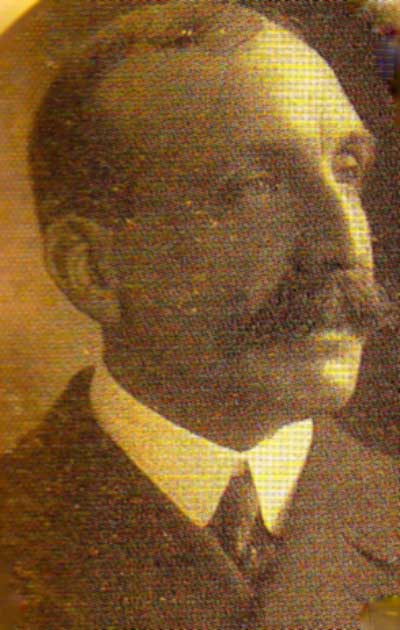 Man of many talents and interests – Arthur F Sharman Crawford contributed much to his adopted home of Cork
Man of many talents and interests – Arthur F Sharman Crawford contributed much to his adopted home of Cork
There’s a book to be written about Arthur F Sharman Crawford (1862-1943), for there’s no way that even a dozen blogs could explain how the Dublin-born English-educated younger son of a northern family with extensive land-holdings in County Down – particularly on the shores of Belfast Lough – came to be the Managing Director of Beamish & Crawford’s brewery in Cork. There, he joined the management team at the age of 28 in 1890, and guided it as Managing Director through some of its most successful periods, and also skillfully negotiated the difficulties of World War 1, the Easter Rising, the War of Independence and the Civil War in a total period from 1914 to 1923, while at the same time being a great benefactor to his adopted city, particularly in the area of technical education, but also in the broader cultural and artistic sphere.
Yet this was no unduly serious do-gooding workaholic. On the contrary, Arthur Sharman Crawford (the family preferred their double surname without a hyphen) was sports mad. A keen yachtsman who was an early owner in the Cork Harbour One Designs of 1896, he was elected Commodore of the Royal Munster YC when it was still at Monkstown in 1898. When it moved to Crosshaven in 1923, as he lived at Lota Lodge in Glanmire north of the harbour, he transferred his full allegiances to the more conveniently located Royal Cork at Cobh where he was already Vice Admiral, and in 1925 he became Admiral and served in that post until 1935.
He also rode to hounds every winter with ferocious enthusiasm, being Joint Master of Cork’s United Hunt for four years. And in later life he played a central role in the establishment of Cork Golf Club, where he served as an actively and frequently-playing President for many years. But in his prime, sailing was his main sport, and he spread his wings far beyond Cork Harbour, for he campaigned on the international scene with a Fife 12 Metre called Ierne, and as a member of many yacht clubs throughout Ireland and Britain, he was a frequent guest helm at regattas, with particularly close associations with the Royal Ulster YC on Belfast Lough.
There, his older brother Robert was Vice Commodore and chaired the committee which oversaw the five challenges for the America’s Cup by Thomas Lipton, the first in 1899 and the last in 1930. The advice of the widely-experienced Arthur was regularly sought by this committee. Yet in other areas of life, there was a parting of the ways between the two brothers. In a time of political restlessness, the northern-based Robert Sharman Crawford was uncompromisingly unionist, and became an active leader in the Ulster Volunteer Force from 1912 onwards. But in the different mood of Cork, the southern-based younger brother had a more accommodating attitude towards Home Rule, reflected in the fact that he continued to play a public role in Cork life, and all his branch of the family were at their deaths buried in the family plot on Little Island in Cork Harbour rather than in the ancestral family lands at Crawfordsburn in County Down.
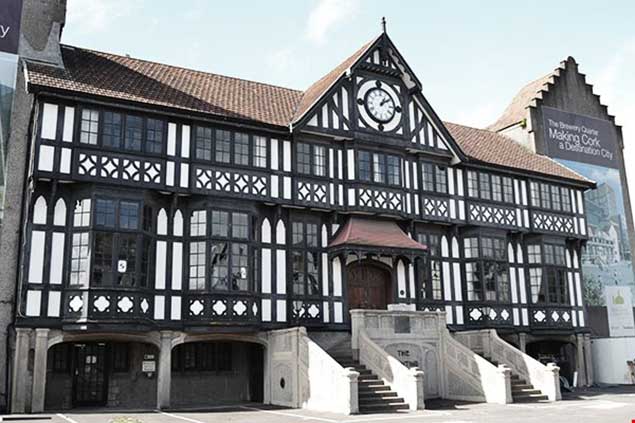 The distinctive Beamish & Crawford Counting House in Cork was built in 1918 during Arthur Sharman Crawford’s long period as Managing Director of the brewery
The distinctive Beamish & Crawford Counting House in Cork was built in 1918 during Arthur Sharman Crawford’s long period as Managing Director of the brewery
There was a very pointed irony in the brothers’ relationship, for even as the brewery in Cork prospered under Arthur’s stewardship, the inherited income from the Crawford estates in the north was shrinking thanks to longterm effects of the activities of Michael Davitt’s Land League and the resultant Gladstone-inspired Land Acts of 1896. The dividends from Cork became an increasingly important part of Robert Sharman Crawford’s income to maintain his opulent lifestyle as a leading yachtsman and as Lord of the Manor of the new loughside Crawfordsburn House, built in the late 1890s to the designs of Vincent Craig. He was the architect brother of Northern Ireland’s future first Prime Minister James Craig (another sailing enthusiast), and his considerable architectural talents were at the same time being deployed for the design of the new Royal Ulster Yacht Club building, which opened in April 1899.
By 1912 and the public declaration of the Ulster Covenant with Robert Sharman Crawford a leading signatory, the fact is that his way of life was largely supported by Beamish & Crawford dividends. It seems only ironic in hindsight – at the time, everyone on all sides though they were doing the right thing. It is only in looking back from the distant and safe viewpoint of 2017 that we realise how curious it was that 104 years ago in 1913, when Colonel Robert Sharman Crawford put his own-funded brigade of the Ulster Volunteer Force through their parades, manoeuvres and exercises on the lawns and fields of Crawfordsburn House, it was all being largely paid for by the continued devotion of the Beamish stout drinkers of Munster.
Yet in that dreamlike pre-World War I era, such activities still seemed slightly theatrical and unreal, and normal life went on at an even more determinedly enthusiastic pace than ever. Having finally agreed a Measurement Rule with the defenders, early in 1914 Thomas Lipton’s latest America’s Cup Challenger, the Charles E Nicholson-designed Shamrock IV, was nearing completion in the south of England. And in the Fife yard in Fairlie in Scotland, a new William Fife designed yacht with an experimental rig was under construction for Arthur Sharman Crawford.
For although Lipton’s technically advanced Shamrock IV carried a very sophisticated gaff rig, it was a gaff rig nevertheless. Thus Arthur Sharman Crawford’s new boat was more important in terms of overall technological development. A more manageable 8 Metre after several successful but demanding years with the 12 Metre Ierne, the new Ierne II was the first yacht to the International Rule of 1907 to set a Bermudan rig.
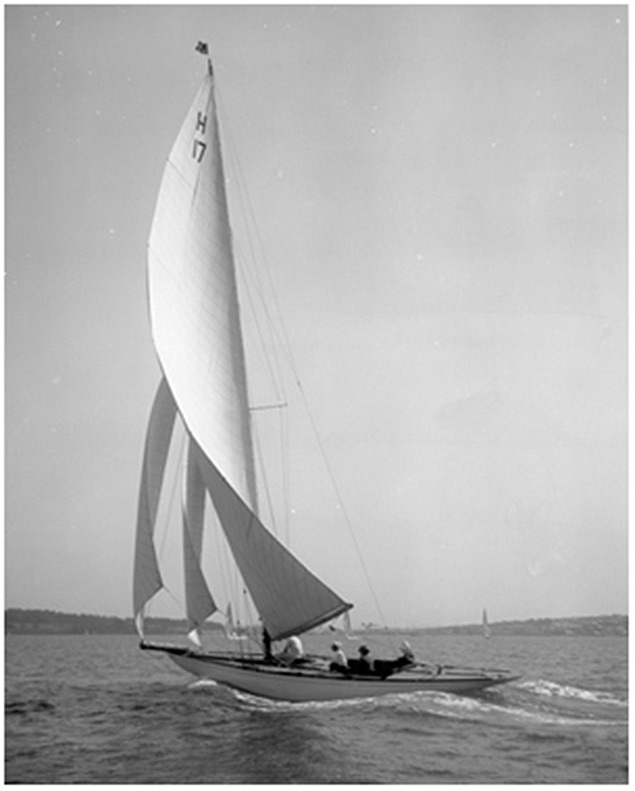 Arthur Sharman Crawford’s 8 Metre Ierne II in 1914, when she was the first International Rule yacht with Bermudan rig.
Arthur Sharman Crawford’s 8 Metre Ierne II in 1914, when she was the first International Rule yacht with Bermudan rig.
Why is she almost totally forgotten in Ireland? Well, Arthur Sharman Crawford led a sort of sailing double life, or even treble life. At home in Cork Harbour, his sailing was local, often using local boats. On Dublin Bay and particularly in Belfast Lough, he was associated with the Lipton camp. But on the Clyde or in the Solent, he was the international or even supra-national yachtsman Arthur Sharman Crawford, challenging the top talents at a rarefied level which was remote from the more localized approach of Cork Harbour or Belfast Lough, and at a tasteful remove from the razzmatazz of Lipton’s America’s Cup challenges.
So when Ierne II appeared fresh out of the wrappers to surprise everyone in the Solent in July 1914, she had never been anywhere near either Belfast Lough or Cork Harbour. It was in the Solent that she made her debut, and for a few very encouraging weeks, while she was undoubtedly a very different creature to sail than a gaff-rigged boat, she was out-performing them all to windward.
It’s intriguing to reflect that when Ierne II was being admired as the hottest new boat in Cowes in late July 1914, briefly in the same harbour at the same time we would have seen Erskine & Molly Childers’ Asgard and Conor O’Brien’s Kelpie pretending to be leisurely cruisers going gently about their business, when in fact they were bound for the Ruytigen Lightvessel to collect their cargoes of Mauser rifles.
Within a couple of weeks, everyone’s plans were in disarray with the outbreak of World War I. All the key figures in the Asgard/Kelpie adventure quickly found themselves positions with the Allied Forces. As for Arthur Sharman Crawford, at the age of 52 this was not an immediate consideration, but his plans for a new programme of fresh excitement for a keen yachtsman past what was then considered the prime of life simply evaporated. Cowes Week 1914 was cancelled completely, and Ierne II was denied the stage which would have provided the setting to enable her to claim her rightful place in sailing history.
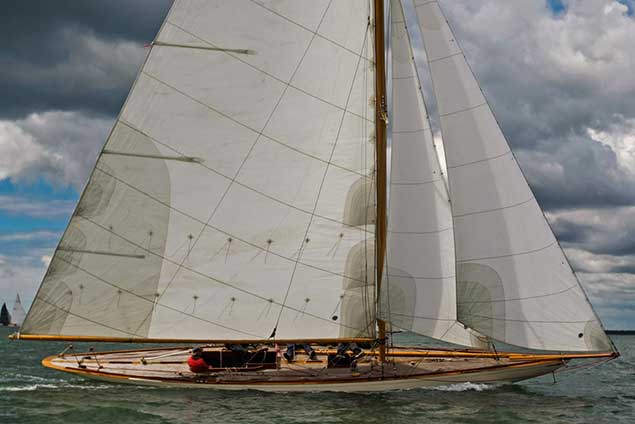 The restored 8 Metre Ierne II is a vivid reminder of Arthur Sharman Crawford’s pioneering instincts.
The restored 8 Metre Ierne II is a vivid reminder of Arthur Sharman Crawford’s pioneering instincts.
Indeed, it was only when noted Yorkshire sailor Hew Jones spotted her laid up in Portugal in 2005 and set about a restoration on Humberside that the whole astonishing story was revealed. When World War II ended in 1918, anyone running a business in Cork amidst Ireland’s growing troubles had other things on his mind, and Arthur Sharman Crawford put Ierne II – laid up since the beginning of August 2014 – on the market. She was eventually bought by Norwegians who wanted a boat for the 8 Metre Class in he 1920 Olympic games in Belgium, and they struck gold in every way, as Ierne II won the Gold Medal.
The top racing sailors were increasingly convinced that Bermudan rig would be where it was at, but in the post war recession, progress was slow. Nevertheless, it was another Irish owner who led the way in the south of England. Elizabeth Workman was the widow of one of the founders of the Workman Clark shipyard in Belfast, and as they at least had done well out of the war, she had the resources to re-commission her 112ft gaff cutter Nyria, designed by Charles E Nicholson and built by Camper & Nicholson in 1906.
Nyria was Solent-based, and following the success of Ierne II and other newly-Bermuda rigged smaller boats in the 1920 Olympics, Elizabeth Workman took the mighty step of getting Charles Nicholson to kit out Nyria with Bermudan rig for the 1921 season, making this the first internationally recognized “big yacht” to do so.
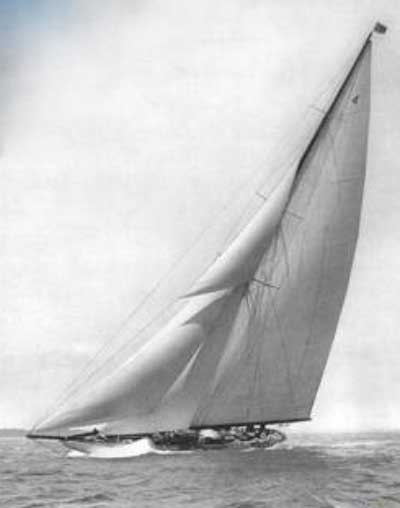 Nyria, owned by Elizabeth Workman of Belfast, in 1921 became the first “big yacht” to be kitted with Bermudan rig
Nyria, owned by Elizabeth Workman of Belfast, in 1921 became the first “big yacht” to be kitted with Bermudan rig
The corner towards Bermudan rig was being turned, and yet another impulse came from Ireland , this time with the commissioning of the world’s first Bermudan-rigged One Design class. The lively Belfast Lough sailing scene of 1914 had been largely destroyed in the trenches of the Somme by the time peace returned in 1918. In an exchange of letters in 1919, some of the more senior members of the Royal Ulster wrote about the need for a new class of boat “which could be sailed by a man and his daughters”. Far from being a gesture for women’s rights, this was simply a sad admission that so many young sailing men would never return from Flanders fields and northern France that it would be 1925 where anything approaching normal manpower levels in sailing would be regained, and so in 1921 the Alfred Mylne-designed Bermudan-rigged 29ft River class made their appearance on Befast Lough. They have never known any rig other than Bermudan, and they continue racing today, though now based on Strangford Lough.
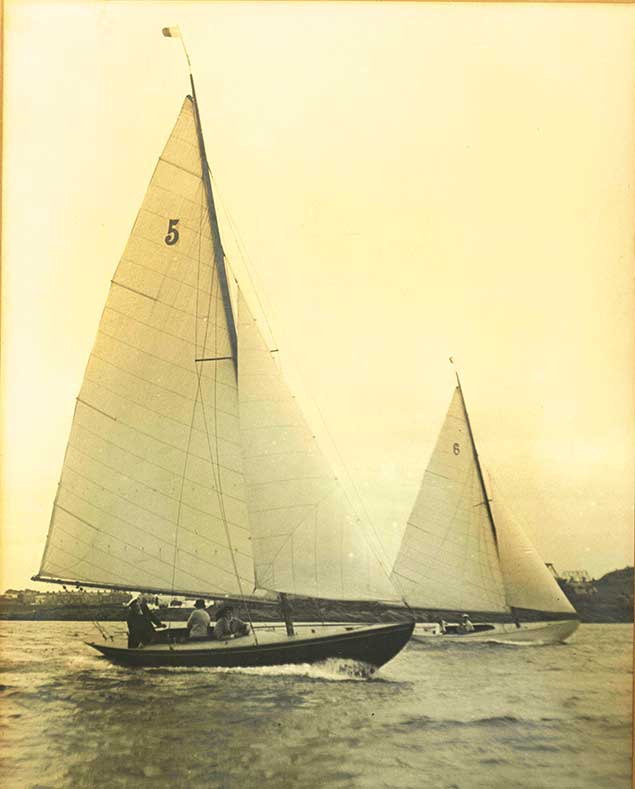 The River Class, seen here racing in Befast Lough in 1921, were the world’s first Bermudan-rigged One Designs.
The River Class, seen here racing in Befast Lough in 1921, were the world’s first Bermudan-rigged One Designs.
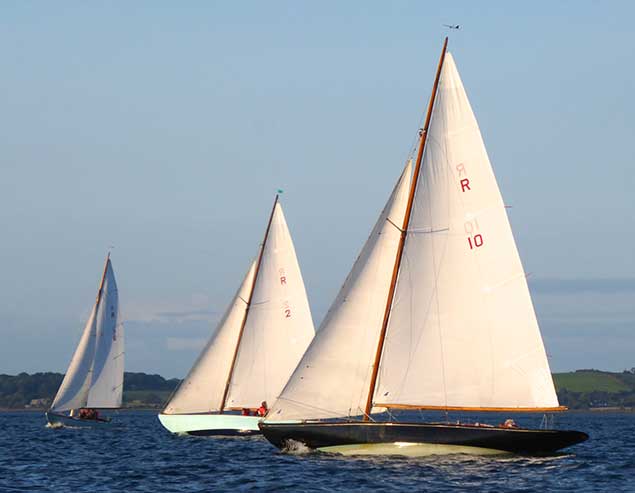 The River Class as they are today in Strangford Lough after 96 years of setting Bermudan rig
The River Class as they are today in Strangford Lough after 96 years of setting Bermudan rig
Thereafter, the move towards Bermuda rig was inexorable and seemingly irreversible, even though sailors as experienced as Billy Mooney of Dublin were ordering the gaff rigged ketch 42ft Aideen to be built by Tyrell’s of Arklow in 1934, and he sailed her so well that he won his class in the 1947 Fastnet Race.
But others were more restless. Since 1898 the gaff-rigged Howth 17s had been sporting their jackyard topsails at their home port north of Dublin, and in 1907 the Dublin Bay Sailing Club adopted the same design, and proprietorially re-designated them as the Dublin Bay 17s. Not only that, but in 1936 a young and competitively successful Dun Laoghaire owner, Terry Roche, decided he would lead the way by converting his DBSC 17 Eileen to Bermudan rig. Despite the fact that she now carried lee helm as he would also have had to move the mast aft to make the new rig balance, he doggedly sailed her to Holyhead and back to prove that all was well. But nobody followed his lead, and after this rather expensive experiment, Eileen reverted to gaff rig and successful racing the following year, and the only lasting memorial of this project is the quaint photo of the Dun Laoghaire waterfront in 1936, a classic image worthy of Cartier-Bresson, with the Water Wags racing off the Royal Irish YC beyond, while in the left of the photo is Eileen sailing under Bermudan rig using mainsail only, which probably balanced quite nicely.
 A quirky photo worthy of Henri Cartier-Bresson. The waterfront at Dun Laoghaire in the summer of 1936, with the Water Wags beyond racing off the Royal Irish YC, and on the left Terry Roche’s Howth/Dublin Bay 17 Eileen in her brief but expensive flirtation with Bermudan rig.Photo courtesy Hilary Keatinge-Roche
A quirky photo worthy of Henri Cartier-Bresson. The waterfront at Dun Laoghaire in the summer of 1936, with the Water Wags beyond racing off the Royal Irish YC, and on the left Terry Roche’s Howth/Dublin Bay 17 Eileen in her brief but expensive flirtation with Bermudan rig.Photo courtesy Hilary Keatinge-Roche
 Howth 17s at Dun Laoghaire again, but this time rigged as nature intended, complete with jackyard topsails. Photo VDLR
Howth 17s at Dun Laoghaire again, but this time rigged as nature intended, complete with jackyard topsails. Photo VDLR
Yet other classes such as the Belfast Lough Island class yawls changed to Bermudan rig in the 1930s, but in Dublin Bay the honour of the gaff rig was stubbornly carried until 1963 by the Dublin Bay 21s, when after sixty years of gaff they converted to Bermudan rig which gave have them another 23 years of active racing life.
Typically of everyone being out of step except Dublin Bay, 1963 was also the very year in which the Old Gaffers Association was founded simply to preserve gaff rig. Ironically, gaff rig is now more visible than ever, albeit above plastic hulls. After all, there are more than a thousand gaff-rigged Cornish Shrimpers sailing the sea.
 Dublin Bay 21 in full gaff rig glory
Dublin Bay 21 in full gaff rig glory
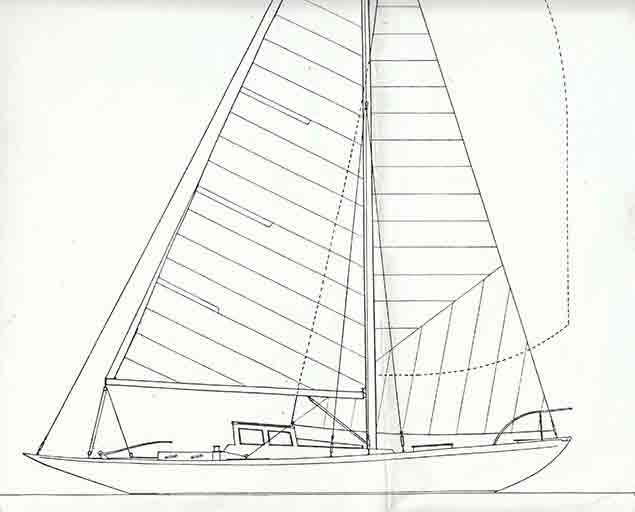 It is 1963, the Old Gaffers Association has just been formed, yet in Dun Laoghaire in 1963 the Dublin Bay 21s make their debut rigged like this……..
It is 1963, the Old Gaffers Association has just been formed, yet in Dun Laoghaire in 1963 the Dublin Bay 21s make their debut rigged like this……..
So is it coming full circle? Maybe. After all, when the America’s Cup multi-hulls start strutting their stuff on Great Sound in Bermuda, they’ll be setting square-headed mainsails which are gaff rig in any sensible definition. And all that where Bermuda rig as we knew it for so long originated more than 183 years ago……
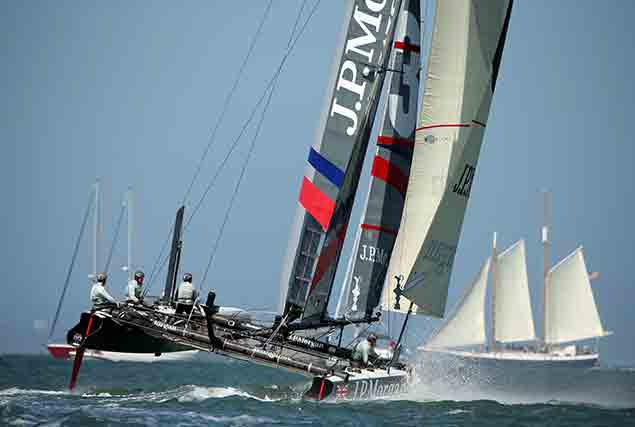 When gaffers meet….one of Ben Ainslie’s America’s Cup boats making knots towards another old gaffer
When gaffers meet….one of Ben Ainslie’s America’s Cup boats making knots towards another old gaffer
But the real test is on Cork Harbour. The reversion to gaff rig came centre stage there last year when the new Ultra National 18s decided the only way to make their otherwise state-of-the-art boats truly sexy was to give them trendy square-topped mainsails.
And if by any chance the spirit of Arthur Sharman Crawford still sails about Cork Harbour, the place he came to love so well, I’ve no doubt he’ll be doing it aboard a ghostly Ierne XXX under a spectral square-topped mainsail, occasionally waxing nostalgic about the old days when he sailed Ierne II with a quaint three-sided mainsail.
 Being fashionable. In 2016, the National 18s Ultras in Cork Harbour reverted to “gaff rig”.
Being fashionable. In 2016, the National 18s Ultras in Cork Harbour reverted to “gaff rig”.
Belfast Lough Recognised At RYA Sailability Awards
#Sailability - Two volunteers with Belfast Lough Sailability received awards at the RYA Sailability National Conference in Cambridge, England last Saturday (18 February).
Bill Foster was awarded the RYA Sailability Exceptional Contribution Award, accepted by BLS chair Paul Bunting, while 15-year-old Eoin Bannon was recognised as Young Volunteer of the Year.
Honorary secretary Anne Taylor attended the conference along with Bunting and Bannon to give a presentation to the more than 200 RYA delegates from around the UK on volunteering, with a focus on encouraging young people to get involved with sailability schemes.
Green Light For Historic Lighthouse Optic On Belfast Waterfront
#MewIslandOptic - Plans to install a rare lens from one of Ireland’s tallest lighthouses on Belfast’s waterfront have been given the green light.
As previously reported on Afloat.ie, plans were announced last summer to house the optic from Mew Island Lighthouse in Belfast Lough in a much more accessible structure designed by architects Hall McKnight.
Now the News Letter reports that planning permission has been granted to install the 130-year-old, seven-metre-tall optic in the Titanic Quarter as the centrepiece of the new Titanic Walkway in the coming months.
“We are now one step closer to helping save and restore one of the largest optics of its kind ever constructed, an artefact of national and international significance,” said Titanic Foundation chief executive Kerrie Sweeney.
“This will certainly create a legacy Belfast landmark which will inspire our future generations.”
The News Letter has more on the story HERE.
Belfast's Harland & Wolff Banks on ‘Holy Grail’ of Decommissioning
#Decommissioning - For many UK ports writes EnergyVoice, developing the facilities needed for large-scale decommissioning projects is a quest they are just embarking on.
But for the Belfast based Harland and Wolff (H&W) shipyard, the asset it describes as the Holy Grail of ship decommissioning has been in place for many years.
The yard that built the Titanic has one of the biggest dry docks in the world, at 556metres in length and 93metres wide, about the same area as seven Wembley football pitches.
David McVeigh, general manager, sales marketing and business development, said the dock is an important feather in Belfast’s cap.
Its thick, high walls are a physical barrier between the surrounding environment and oils and other contaminants that could accidentally spill. It keeps H&W in line with the 1992 Basel Convention on the transfer and disposal of hazardous waste materials.
Ports with piers or slipways may have well thought out safeguards against spills, but from an environmental viewpoint, they cannot offer the same level of assurance on decommissioning.
H&W also has a waste management licence for ship and offshore unit recycling, not to mention the two giant yellow cranes, Samson and Goliath.
Mr McVeigh said H&W’s offering means it should appeal to those who take their environmental responsibilities seriously. He said: “Our facilities are huge. We have big quaysides and one of the biggest dry docks in the world.
It means we can offer environmentally credible solutions. “Some customers would place the economics above the environmental impact. We’ll still see vessels going outside EU to places that are not as concerned about environmental issues as we are. If someone is looking for a cheap solution they’re not going to come to us, but if someone values the environment, we are well suited to deliver.”
Mr McVeigh said that while decommissioning is not a big earner for H&W, the yard will be “ready to go” when the market kicks into gear.
To date, perhaps the biggest decommissioning job H&W has handled was that of the MSC Napoli container ship (see Belfast coverage photo), which was beached in Lyme Bay in the English Channel in 2007. The job could quite easily serve as a dress rehearsal for the decommissioning of a floating production, storage and offloading vessel in the coming decades.
Dismantling topsides could be part of the mix, too. Mr McVeigh said H&W had carried out a dock appraisal to demonstrate that Allseas’ mammoth Pioneering Spirit, which will remove Shell’s Brent Delta platform in summer 2017, could work within the harbour’s existing facilities.
For more and also manufacturing installation project click here.
NATO Warships Visit Belfast Lough On Watch For Russian Vessels
#NavalVisits - The Royal Navy’s HMS Duncan was among a fleet of NATO warships that sailed into Belfast Lough on Friday 4 November, as ITV News reports.
The Type 45 Destroyer, only the second of its kind in Northern Ireland’s waters, is part of a four-ship fleet comprising frigates from Spain, Portugal and Germany that had been scheduled to visit last month.
However, they were diverted to monitor a number of Russian warships passing through British waters en route to Syria.
The visit this weekend followed reports that Russian submarines had been tracked through the Irish Sea in recent weeks, as previously covered on Afloat.ie.



























